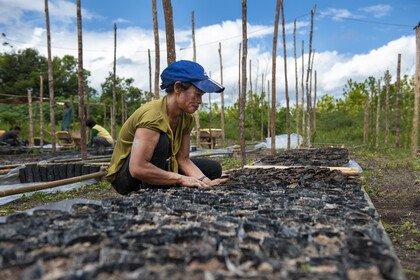
How collaborating with Indigenous communities can lead to meaningful climate action
Indigenous communities have been using ‘cultural burning’ for centuries. Dr Nicole Redvers explores how this traditional practice could help us rethink fire management.

Wellcome
I’m a member of the Deninu Kųę́ First Nation in the Northwest Territories in Canada. Growing up, I would often see a very particular looking sun called the smoke sun. This is when the sun appears red or orange as ash constantly falls from the sky during a wildfire.
We’re seeing the smoke sun more often these days as wildfires have become more common and exacerbated by climate change. In 2023 alone, the Northwest Territories’ region in Canada had 306 wildfires [PDF 9.8MB].
Indigenous communities like mine are among the most vulnerable to wildfires as we generally live closer to nature. We also don’t have appropriate infrastructure like air filtration systems or sealed buildings to keep out smoke. Many Indigenous Peoples have longstanding and repeated exposure to wildfire smoke for years, putting their health at risk.
But as it stands, there hasn't been sufficient investment in longitudinal and long-term studies around wildfire exposure to fully understand the impacts on our health.
So far, we only have some preliminary studies giving us an indication of the health risks of wildfires – for example, the potential cardiovascular and respiratory health impacts. How wildfires affect mental health is also substantially under-researched.
So, for millennia Indigenous Peoples have developed ways to mitigate wildfires and the health effects they bring. One of these strategies is a practice called cultural burning, also known as prescribed burns, controlled burns or beneficial burns.
Now, we’re seeing scientific evidence that our traditional practice is effective.
An opportunity to bridge traditional knowledge and modern science
Cultural burning is an Indigenous community-based practice where controlled fire is used to manage landscapes like forests. These work by reducing dried, flammable vegetation in a manageable way.
There’s a nuanced difference to the prescribed burns in a Western context. Prescribed burns are acutely for the purpose of preventing wildfires and use modern technology. Indigenous-led cultural burning follows cultural objectives and uses slow, cool burns. It’s a fire you can walk beside. The practice is very family-centred and uses traditional fire ignition methods.
Techniques and strategies around the practice can vary depending on the landscape and the knowledge that has been passed down within an Indigenous community. For example, some might look for clues to determine the appropriate time for cultural burning. A clue can include checking whether berries are not as full and plump as they should be.
Colonisation eventually changed those practices. British Columbia, on the western part of Canada, was among the first to ban it in 1874. Provinces and many states in the US followed suit. There were also very strict fines for continuing to practice cultural burning within Indigenous communities.
But we’re now seeing increased interest around Indigenous traditional knowledge of cultural burning. What’s more, we’re seeing scientific evidence of its advantages and as a result better understanding of this traditional practice.
One research project, led by Dr Kari Nadeau from the Harvard T.H. Chan School of Public Health, observed the health of children exposed to wildfire compared to prescribed fire. The results showed air from wildfire smoke was much more toxic and that prescribed fire was not as risky for human health as originally thought.
The data from this research has since informed policymaking around adapting beneficial fire to prevent severe wildfires.
In Canada, the federal government and some provinces have started to partner with Indigenous Nations to bridge traditional knowledges and modern science. In 2022, California reversed a policy that banned cultural burning, supporting Tribes to mobilise the practice again.
This shows us the potential of bridging traditional knowledge with modern science – and how it can lead to meaningful action to mitigate the health impacts of climate change.
Ensuring meaningful collaboration with Indigenous Peoples
It's encouraging to see that science is finally catching up to what Indigenous Peoples have been saying for generations. But what we must take care to do next is ensure Indigenous Peoples are centred in forging a path forward.
There can often be a focus on Indigenous knowledges, but not Indigenous Peoples. The question has often been, ‘How can we integrate traditional knowledges into what we already know in Western science?’ But what about the other way around?
The knowledge does not come without the people. As science looks to Indigenous Peoples for ways to tackle the health impacts of climate change, it’s crucial to avoid extractive approaches. Establishing equitable partnership is key to achieving this.
Meaningful collaboration will also go a long way in research to understand the health impacts of wildfires – and to develop effective solutions. It’s an opportunity for researchers to include lived experience expertise such as those of Indigenous Peoples at every stage of their projects – and to do so the right way.
It’s not just about bringing Indigenous Peoples to the table. We need to reflect about what that table represents. Is it a Western table that Indigenous Peoples are invited to sit around? Ultimately, it’s about genuinely supporting Indigenous communities doing the things they have done for generations.
Hear more from Nicole in our podcast, When Science Finds a Way.
This article was first published in 'Behind the Research', our LinkedIn newsletter sharing insights and stories from experts in global health research.


